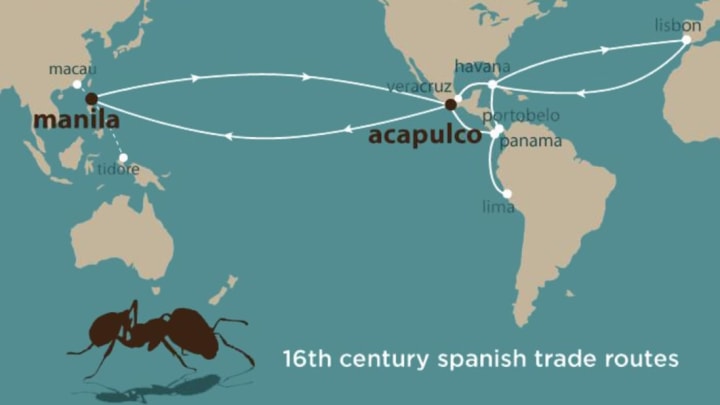16th Century Spanish Ships Took Tropical Fire Ants Around the World

Before 16th century Spanish sailors set off on long voyages across the Pacific Ocean from the port city of Acapulco, Mexico, they filled the ballasts of their ships with dirt to keep the vessels steady in high winds and rough seas. When they reached their destinations in the Philippines, the sailors replaced the soil with cargo, leaving the dirt behind. What they couldn’t have known was that they were also leaving behind what was in the soil: Tropical fire ants (Solenopsis geminata).
A new study, conducted by scientists at the University of Illinois and the University of Vermont in conjunction with the U.S. Department of Agriculture and published in Molecular Ecology, has revealed that these insects—once found only in the Americas but now located in tropical environments worldwide—hitched a ride to the Philippines in Spanish ships, making S. geminata the first ant species to travel the globe by sea.
Ants were the ideal subjects to use to test the potential impact of early global trade in the spread of species because, the scientists write in the paper, “they are readily moved via ship transport, making them highly susceptible to human dispersal. There are a number of widespread ant species with global or near global distributions. Their native ranges are often unknown, as is accurate and detailed historical documentation of their spread.”
It was uncertain which region of the world the tropical fire ant originally called home, but the researchers hypothesized that the original population of ants would have the most genetic diversity, and that any ants that came from that population would have a subset of that diversity. To test their theory, the scientists not only looked for patterns in the mitochondrial DNA of fire ants from 192 locations, but also in the patterns of Spanish ships, analyzing historical records and trading routes to and from the New World in the 16th century, when the Spanish had just set up the first trade route across the Pacific Ocean between Acapulco and the Philippines.
Julie McMahon
The genetic data confirmed the scientists’ hypothesis, documenting “a corresponding spread of S. geminata from Mexico via Manila to Taiwan and from there, throughout the Old World,” they write in the paper.
“The ants from the introduced areas in the Old World are genetically most similar to ants from southwestern Mexico, suggesting that their source population came from this region,” Andrew Suarez, an entomology professor at the University of Illinois, said in a release. “There was this very clear pattern where there was the most genetic diversity in the New World, where it's native, and then you see these stepping stones of nested subsets of diversity as you move away from the New World into the Old World.”
The study shows just how useful studying genetic data can be when looking for patterns in how species have dispersed. “Uncovering events that happened long ago, before the age of digital tracking codes and customs enforcement, is often a difficult task," University of Vermont biology professor Sara Helms Cahan said. "Luckily for us, however, it turns out that invasive species keep their own records of their history, encoded in their genomes."